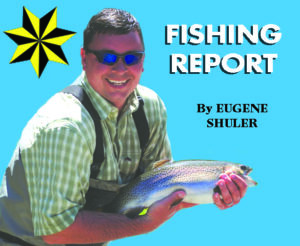 Noisy wading has saved more trout’s lives than catch and release fishing ever did. It’s true, stomping and splashing about while wading will send trout into the next zip code, leaving you empty handed. Do this at every fishing spot you come to, and you’ll likely get skunked.
Noisy wading has saved more trout’s lives than catch and release fishing ever did. It’s true, stomping and splashing about while wading will send trout into the next zip code, leaving you empty handed. Do this at every fishing spot you come to, and you’ll likely get skunked.
Trout have inner ears and can hear sounds much like we do. They also have what is called a lateral line which basically is a series of sensory organs that run down the entire length of their body. They are usually visible as faint lines running lengthwise down each side of the fish. This lateral line can feel and sense sounds and pressure, giving the fish awareness to its surroundings and movement in the water. Imagine how well you could hear if you had an ear that was as tall as you are. You wouldn’t miss a thing, and neither does a fish. Every time you step heavily in the water, the fish know you are there, and where you are, without ever having to see you.
When wading it is a good idea to step softly in the water and disturb as little as possible. Try not to pick your feet up above the water surface as this will create even more sounds and splashes. You want to avoid sending shock waves through the water that could alert a fish. Have you ever watched a Blue Heron work the water after a fish? The Heron wades out slowly and doesn’t make quick or unnecessary movements. Consequently, the Heron is the most successful fisherman on the water. I tell my clients to imagine they are sneaking up on a rabbit. It’s the same principal when stalking a fish.
The fishing around the Smoky Mountains just keeps getting better. The hottest action this week will be found in Cherokee. The rivers and streams will be stocked heavily in anticipation for the Cast into Spring Fishing Tournament on March 28-29.
The upper Nantahala River in the Delayed Harvest section above the powerhouse will also be fishing great. Lots of insect hatches are keeping trout actively feeding, and dry fly fishing is becoming increasingly good. The lower Nantahala River below the power house remains closed until the first Saturday in April.
The Great Smoky Mountains National Park is fishing very well now. Springs like temperatures have the trout happy, and mid-day action can be fantastic! Hatches of Quill Gordons and dark Caddis are starting around 10am and continue throughout the afternoon. Early season Stoneflies are also starting to show on sunny days. Along with happy trout, the critters on the park are also starting to come out from a long winter. Turkeys are strutting their stuff, and elk are starting to become very active. We have seen a couple bears roaming around searching for food too.

Joseph Orange, from Kirklin, Ind., shows off a 22-inch Rainbow trout he caught in the Tuckasegee River. (Photo courtesy of Eugene Shuler)
Fishing on the Tuckasegee River Delayed Harvest section is still very good. Anglers fishing here are catching the biggest numbers of trout all season long. Some folks have claims of over 100 fish per day. Keep an eye on generation schedules as the water rises rapidly especially if the water is coming from the East Fork. The guides call it the Beast of the East. Water flows from this fork can easily top 800cfs and looks like a wall of water coming at you.
Best flies are;
Blue Duns #14-18, Quill Gordon dries #12-14, Little Black Caddis in #14-16, Little Winter Stonefly nymphs in #14-18, Little Winter Stonefly dries in #14-18, Blue Winged Olives in #18-22, Quill Gordon nymphs #12-14, Pheasant Tail Nymphs #12-18, Hares Ear nymphs #12-16, egg patterns in #10-12, Rainbow Warriors in #14-20, and black midges in #22-26. For Streamer patterns try black and olive Woolly Buggers in sizes #6-8, dark brown Sculpins in #6-8, and black Rabbit Strip Zonkers in #6-10.
Fontana Lake is just starting to see some Walleye action in the creek and river mouths. Some early Walleye are starting their spawning runs, along with White Bass and Crappie. Of course fishing close to the banks is the best idea or near rocky bottoms. Anglers are catching their limits using live minnows and night crawler rigs worked slowly fishing late afternoon and into the night. Largemouth bass fishing is becoming increasingly better. Mid-day flats and points next to deep water seem to be the hot ticket. Largemouth will move up along the depths as the day goes by and make for great fishing using rattle traps and working jigs.
Remember to check area fishing regulations as “March Madness” still applies. Regulations and season closures will vary between watersheds and designations. Know the regulations before you make that first cast. Please show respect for your Game Wardens, Park Rangers, and Wildlife Officers, they have far more of a dangerous job than most realize. Each has a job to do, and wants to go home at the end of the day just like you. They are here to protect our natural resources for everyone to enjoy for years to come.
See you on the water!





